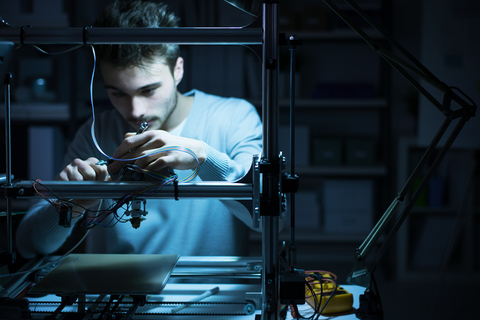Woman rebuilds people’s faces by designing and 3D printing state of the art implants

A new digital job created at Morriston Hospital in Swansea is thought to be the first of its kind in the NHS (WalesOnline, 2017).
Health board bosses say Heather Goodrum is the first person to be appointed to the role of biomedical 3D technician at any NHS hospital carrying out maxillofacial surgery, the treatment of injuries and diseases affecting the mouth, jaws, face, head and neck.
Heather Goodrum could have used her skills to specialise in facial reconstructions from skulls, in the same way that Richard III’s face was reconstructed after his skull was found during the archaeological excavation of a Leicester car park. Alternatively she could have worked with police, drawing faces for e-fits based on witness descriptions.
Instead she helps maxillofacial consultants plan reconstruction surgery, designing implants and cutting guides which are 3D printed once they have been approved. The implants and cutting guides are designed using the patient’s own CT images. The highly accurate designs save theatre time.
Heather Goodrum did her BA Hons degree in theatre design at Nottingham Trent University, where she developed an interest in digital design and 3D software for the stage. After that she completed her masters in facial forensic art, doing reconstructions from skulls, first using clay and then digitally. She then became interested in how the digital work could be applied to maxillofacial surgery.
She said “The surgeons decide how they want to be able to do the surgery and the design side is then down to me and the reconstructive scientists in our team. I’ll design the part required and the team and I sit down together to make any alterations. Once complete it is sent away for 3D printing.”
Peter Llewelyn Evans, maxillofacial laboratory services manager at Morriston Hospital, said the service created a range of implants and prostheses, including legs, breasts and ears, although Heather Goodrum’s role was mainly in head and neck surgery.
Peter Llewelyn Jones said “The digital 3D planning for head and neck reconstructions has really grown in the last five years or so. Units are struggling to do the digital work because they have not had anyone specifically trained to do it. The role didn’t exist in the NHS so we created a special post as we felt it was something that would continue to grow.”
Heather Goodrum said she enjoyed the variety of her role, as she was able to work on implants for a range of procedures. She said “I’ve also learnt a lot from being able to go into theatre and getting feedback straightaway. You’re really part of the team and you do develop a rapport with the surgeons. You know you are literally helping patients rebuild their lives.”
Peter Llewelyn Evans said having digitally designed and 3D printed implants meant better outcomes for the patients, as they were a perfect fit. It also saved surgeons’ time as they no longer had to shape the implants by hand.
He said “Other large centres around the UK have been in contact about Heather’s role because they want to create a similar post in their units. So it’s great to be able show another innovative approach to patient care from ABMU.”








